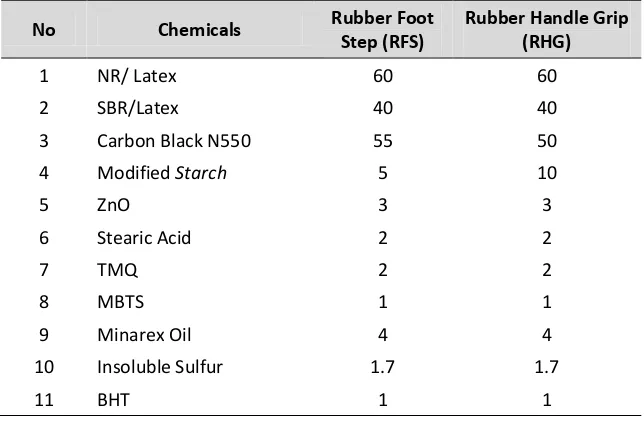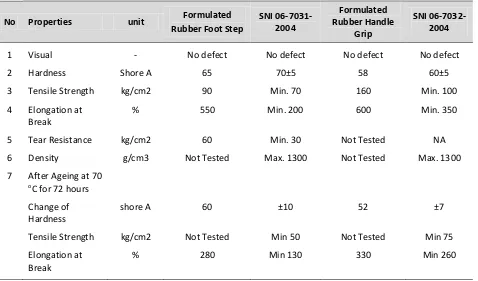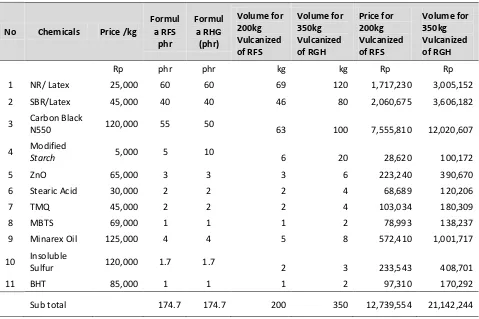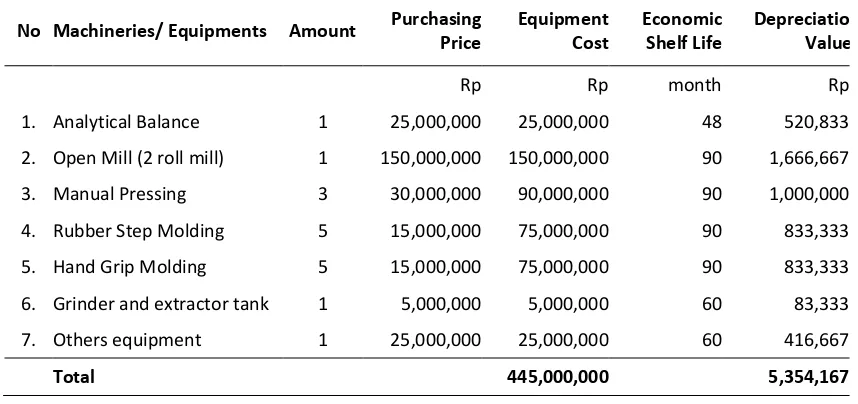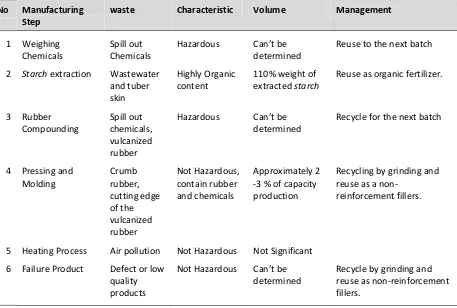KAJIAN KELAYAKAN PENGEMBANGAN INDUSTRI INOVATIF SKALA KECIL
MENENGAH UNTUK PRODUK KARET OTOMOTIF
Tri Susanto
Balai Riset dan Standardisasi Industri Palembang E-mail: 3trisusanto87@gmail.com
ABSTRAK
Tujuan dari penelitian ini adalah untuk mempelajari kelayakan pada pengembangan produk karet otomotif yang inovatif di Small Medium Industries (IKM) dengan prinsip industri hijau. Produk Produk karet suku cadang otomotif yang dikaji adalah karet pijakan kaki (RFS) dan karet pegangan stang kendaraan bermotor (RGH), sedangkan inovasi adalah pendekatan berbasis industri hijau pada IKM. Penelitian ini meliputi inovasi pada teknologi proses produksi, menganalisis aspek ekonomi dan mengusulkan rekomendasi pengelolaan limbah untuk industri. Analisis deskriptif SWOT dilakukan untuk menentukan inovasi pada penggantian karbon hitam (CB) dengan pati termodifikasi pada proses pembuatan vulkanisat karet. Analisis tekno ekonomi dihitung untuk menentukan keuntungan inovasi, sementara analisis deskriptif pada pengelolaan limbah IKM juga dijelaskan juga dalam penelitian ini. Hasil penelitian menunjukkan bahwa pati termodifikasi dapat digunakan sebagai pengisi alternatif dalam pembuatan vulkanisat karet tanpa investasi mesin baru atau mengubah proses produksi. Berdasarkan pemenuhan kualitas produk SNI 06-7031 2004 (Karet Foot Step) dan SNI 06-7032-2004 (Rubber Handle Grip), jumlah CB yang bisa diganti hanya sekitar 15-20% untuk setiap produk. Selanjutnya, analisis ekonomi techno dengan kapasitas vulkanisat karet 550 kg/bulan akan memiliki B/C ratio 1,2. Dapat disimpulkan bahwa inovasi ini layak secara ekonomi dan teknologi serta mudah diadopsi oleh IKM. Prinsip reuse dan recycle dalam pengelolaan limbah padat IKM ini adalah direkomendasikan untuk meminimalkan dampak lingkungan.
FEASIBILITY STUDY ON DEVELOPING INNOVATIVE SMALL MEDIUM INDUSTRIES
FOR AUTOMOTIVE RUBBER PRODUCTS
Tri Susanto
Balai Riset dan Standardisasi Industri Palembang E-mail: 3trisusanto87@gmail.com
ABSTRACT
The objective of this research was to study the feasibility on developing the innovative automotive rubber products in Small Medium Industries (SMIs) which based on greening the industries. The rubber products were subjected to handle grip and rubber step as automotive spare parts, while the innovation is the greening of the SMIs. This study included how to innovate the technology aspect, analyze the economy aspect of its innovation and propose waste management recommendation for the SMIs. Descriptive SWOT Analysis was conducted to determine the innovation on partially replacing the carbon black (CB) with modified starch in rubber compounding. Techno economy analysis was calculated to determine the profitability of the innovation, while descriptive analysis on the waste management SMIs was also explained in this paper. The results showed that modified starch could be used as alternative filler in rubber compounding with neither invest new machineries nor changes the process production. Based on product quality fulfillment of SNI 06-7031 2004 (Rubber Foot Step (RFS)) and SNI 06-7032-2004 (Rubber Handle Grip (RHG)), the amount of CB that could be replaced was only about 10-20% of CB. Furthermore, techno economy analysis with the capacity of 550 kg rubber vulcanized monthly would have B/C ratio 1,2. To sum up, it is inferred that this innovation is economically feasible and technologically viable that could be easily adopted in the SMIs. In addition, reuse and recycle principal in waste management in rubber products manufacturing are recommended to minimize the environmental impacts of this SMIs’ activities.
Keywords: green automotive rubber products, modified starch, techno economy analysis, SMI, waste
INTRODUCTION
As the second highest rubber producer country in the world, Indonesia has not developed a rubber goods industry well, the fact that the number of natural rubber exported is high approximately 85% for a period of one decade (Arifin, 2005; Darmawan, Putra, & Wiguna, 2014; Susanto, 2015). Indonesia has produced natural rubber since 1980 in such kind of Ribbed Smoke Sheet with varied quality, concentrated latex approximately 60% rubber content and crumb rubber which is the main exported product (Arifin, 2005; Hadi & Budhi, 1997). Therefore, The strategy of developing rubber sector industries are to increase yields and grow industries of downstream rubber products. In accordance with the theme of development and strategies to accelerate economic growth in the rubber sector, it is necessary to focus on the expansion of the downstream rubber industry such as: industrial tires, V-belts, conveyor belt, rubber tubing, metal packaging, cable, rubber pads, rubber rollers, sponge rubber and foam (Ikhsan, Aid, & Pertanian, 2011; Wibawa, Hendratno, & van Noordwijk, 2005). Indonesia classifies the rubber goods industry in to 4 categories namely a) foreign tire and tire industry, b) tire retreading industry, c) manufacture of rubber goods for the purposes of household, d) manufacture of rubber goods for industry and e) other manufacture of rubber goods (Hadi & Budhi, 1997; Lawrence, 1996; Penot, 2004; Rizkyanti, 2016).
The fact that there is only a few rubber based industries in South Sumatera and Jambi, since this province is the highest productivity rubber in Indonesia is a big challenge (van Noordwijk, Tata, Xu, Dewi, & Minang, 2012; Wibawa, et al., 2005). For instance, there is no rubber based industries using a simple technology such as vulcanized compound, latex processing, or other rubber products. Mostly rubber products are traded as crumb rubber, whereas the added value and economic value is only for the crumb rubber factories, not for the farmer along the rubber supply chain (Arifin, 2005; Susanto, 2015). Therefore, it is an urgency to develop the downstream rubber products in small medium industries to enhance the welfare of farmers in South Sumatera.
Currently, the rubber goods industries hasn’t been grown significantly in South Sumatera. In order to
maximize the added value of natural rubber along its supply chain, growing SMIs based on natural rubber need to be prioritized in short term development government program (Sadikin & Irawan, 2006; Siregar, 2006). Based on the considerations of capital, technology, resource, environmental aspects and risk of business as well as market prospect, developing automotive spare part is recommended for SMIs. With regard to the market prospect, technological aspects and product quality, rubber products such as rubber foot step and rubber handle grip as automotive rubber products would be studied in this paper. Furthermore, based on the SNI requirements of SNI 06-7032-2004 and SNI 06-06-7031-2004 respectively for the products, it is believed that the SMIs could met this standard.
the others (Sareena, Ramesan, & Purushothaman, 2012; Wolff, et al., 1993; Y.-P. Wu, et al., 2006; Y. P. Wu, Ji, Qi, Wang, & Zhang, 2004). However, regarding to low cost, high availability, ease of chemical and mechanical modification, and high specific mechanical properties, starch could represent a good, renewable and biodegradable alternative to the most common synthetic reinforcement (Y. P. Wu, et al., 2004).
In this product innovation, this paper tried to study the using of modified starch to partially replace the CB in rubber compounding as well as calculate the economy aspects of this innovation. It is found that starch are potentially partially replacing CB in rubber compounding in a certain portion without decrease the quality of the rubber products (Corvasce, Linster, & Thielen, 1997; Liu, Shao, & Jia, 2008; Sareena, et al., 2012). In this paper, the modified starch that would be proposed is non-edible starch, so that it will not counter the staple food supply chain. This project would use the starch extract of Dioscorea Hispida Denst tuber (Umbi Gadung) is a toxic tuber which is non consumable for human and animals. Furthermore, with regard to the fulfillment of products quality, this innovation is a low technology investment, less risk of business as well as less safety requirements for its function. Therefore, it is a golden opportunity to diffuse or do this innovative SMIs in South Sumatera. This paper would study this business innovation by greening the SMIs through analyze the technological aspects, the economy aspects by calculating the B/C ratio and recommend an easy adoptable waste management.
METHODOLOGY
The data were collected during March 2015 until August 2016 through interview, field observation and literature review. The questionnaire and list of interview questions were formulated based on some literature reviews of rubber products manufacturing, waste management in SMIs. The respondents are rubber technology experts, entrepreneurs, director of crumb rubber factories, and researchers in BPTK Bogor and Baristand Industri Palembang. The experts discussed the content of interview question to improve the precision of some questions. An interview script that had open-ended questions was used. The semi-structured interviews were personally conducted and recorded, mostly about 30-60 minutes for each respondent; a series of notes was made during the interviews. The interviews were in Indonesian, being the mother language of researchers and respondents; it gives more benefits to the sharing of ideas. In addition, field observation is also helpful in overcoming discrepancies between the interview and the actual condition; this might help uncover behavior of which the participants themselves may not be aware. The other data were also collected in Statistic Bureau in 2015. While, the research results or data from the other researchers that used, cited, explained, shown or reproduced in this paper are written with permission or proper citation.
In terms of data analysis, all interviews were audio recorded on tape, and interviews are listened to repeatedly and continually coded as proposed. The collected data were organized and coded based on the research questions, and then analyzed through thematic analysis. After the coding of the material, some nodes were created and categorized following the already established framework from the literature review. The generated nodes were again refined, and subcategories formed. In terms of construct validity, this research collected data from multiple sources like qualitative interviews, scientific literature, field observation, and financial analysis. Those helped in establishing a chain of evidence of the research.
RESULTS AND DISCUSSION
Technological Aspects
In the manufacturing of vulcanized rubber there are three factors that need to be considered, namely the nature of compounding, processing characteristics and cost. The composition of the rubber compound varies depending on the objective of making the finished rubber goods. Before the rubber raw material is mixed with chemicals, firstly the raw material rubber being plasticized, and after chemicals could be mixed directly (Morton, 2013). Before the rubber vulcanized is produced, we should take account the physical properties of the finished rubber goods. The physical and mechanic-physical properties that are needed depending on the type of rubber goods namely hardness, elongation at break, after ageing, abrasion resistance, tear resistance, oil resistance, and resistance at high temperatures and the oxidation (Bhowmick, 1994; Morton, 2013). Basically the process of rubber compounding is the same for each type of finished goods, but the formulation of chemicals and vulcanization process are slightly different.
Rubber compounding includes mixing rubber with chemicals. This process consists of several stages, namely the mastication, mixing and vulcanization (Bhowmick, 1994; Morton, 2013). Mastication is the process of softening (plasticizing) elastomers, as a preparatory step for the process of mixing with the aim that the chemicals are added to mix homogenously. Rubber grinding process to achieve the desired plasticity, with the aim that the mixing of the rubber chemicals easier and more softly. Visually mastication stopped if the rubber is enough plastic that is marked with a sticky rubber compound has covered the surface of the roller and the rubber windings look smooth and there are no air bubbles again. Mixing is the entry process auxiliaries into raw rubber which mastication process has been completed in order to obtain a uniform mixture. The main goal is to make the process of mixing rubber compound to form a homogeneous, constant plastic and elastic property of rubber vulcanized (Morton, 2013). Mixing used an open mill with mixing temperature of 70±5°C for 30 minutes. Vulcanization is a term used in the industry to describe a process by which the rubber is reacted with chemicals primarily Sulphur, usually in hot conditions, so that the plasticity of rubber polymer becomes elastic (Bhowmick, 1994; Morton, 2013).
Chemicals for rubber vulcanized broadly grouped into seven principal categories, namely material curing agent, accelerator, activator, anti-degradation, fillers, softeners, and materials - special materials (Bhowmick, 1994; Morton, 2013; Wolff, et al., 1993). Each type of materials has a specific function and has an influence on the properties, processing characteristics and the price of the vulcanized rubber. In terms of rubber vulcanized compounding, the most important for determining the type or mixture of raw rubber such as natural rubber or synthetic rubber SBR, NBR, EPDM or the others polymer. In addition, the filler agent such as reinforcement or non-reinforcement as well as the composition of all material would yield the different psycho-chemical properties of the final rubber products (Dannenberg, 1975; Wang, 1998). Process production includes compounding and pressing - casting. Compounding is the mixing of rubber or elastomeric with some chemicals, then rubber vulcanized yielded will be rested for 1 until 2 days to ensure the stabilization and release some gases. After it, the next step is pressing and casting to produce rubber foot step rubber and rubber handle grip.
as reinforcement filler have been done, while the using of modified starch is still limited. However, it is suggested that starch that priorly modified using Latec Compounding Method could be used as reinforcement filler in a certain portion to substitute Carbon Black in rubber compounding (Susanto, 2016, (Liu, et al., 2008; Lu, et al., 2006; Y.-P. Wu, et al., 2006; Y. P. Wu, et al., 2004). The finding of the results suggested that using modified starch is an appropriate option in rubber processing technology. Therefore, in this paper, developing the SMIs based on modified starch is analyzed using SWOT to describe the advantages and disadvantages of the innovation. The result of SWOT Analyis is shown in Table 1.
Table 1. SWOT Analysis of Selecting Modified Starch (extract Dioscorea H Denst) to Substitute Carbon Black in Rubber Compounding for Rubber Foot Step and Handle Grip
Strength
Reduce the number of CB in rubber compounding
High profit
Threat
The availability of starch is limited in the plantation
Decrease the physic-mechanic properties of rubber products
Low quality of final products
Practically, the modified starch that used to replace CB was prepared by extracting Dioscorea H Denst by dissolving it in the water as explained by Susanto (2016). In order to modify the starch before mixing it in rubber compounding the process was explained in the paper by Susanto (2016) as well as the procedure in compounding is the same as that research. The formula of rubber foot step and handle grip is shown in Table 2. The formula that shown in the table 2 was chosen based on the criteria fulfillment as required in the SNI 06-7031-2004 and SNI 06-7032-2004, while the test results is listed in the table 3. Those data are adopted and cited from Susanto (2016). However, in RFX compounding, it is only 10% of CB could be replaced, while in RHG is about 20% of CB.
Table 2. Rubber Formula for Rubber Foot Step and Rubber Handle Grip
The basic factor that has to be considered in developing the SMIs is the elastomeric, to optimize the using of natural rubber in plantation area, the formula will use the natural latex, as a concentrated latex that could be made easily using low technology in farmer scale without heavy equipment and low energy consumption. The production process is not as complex as crumb rubber factories. This is the other advantages of this innovation that is reducing the production cost as well as simplifying the technology adoption for SMIs. It is noted that all chemicals are available to buy in South Sumatera.
Table 3 shows the physical properties of RFS and RHG which both of the products are fullfilled the SNI requirements. The innovation by substitute the CB using modified starch is viable technologically. It is proven by testing the prototype of the product.
Table 3. Physical Properties of Rubber Foot Step and Rubber Handle Grip
No Properties unit Formulated Rubber Foot Step
SNI 06-7031-2004
Formulated Rubber Handle
Grip
SNI 06-7032-2004
1 Visual - No defect No defect No defect No defect
2 Hardness Shore A 65 70±5 58 60±5
3 Tensile Strength kg/cm2 90 Min. 70 160 Min. 100
4 Elongation at Break
% 550 Min. 200 600 Min. 350
5 Tear Resistance kg/cm2 60 Min. 30 Not Tested NA
6 Density g/cm3 Not Tested Max. 1300 Not Tested Max. 1300
7 After Ageing at 70
oC for 72 hours
Change of Hardness
shore A 60 ±10 52 ±7
Tensile Strength kg/cm2 Not Tested Min 50 Not Tested Min 75
Elongation at Break
% 280 Min 130 330 Min 260
Techno Economy Analysis
Table 4. Cost Production Monthly
Table 4 and Table 5 show the cost production of RFS and RGH by estimate the material consumption for the products and wages for the 3 labours. In this calculation, the number of labours was estimated 3 people since this production process is less skillfull. The prices in those tables are estimated based on Palembang in
2016, especially for the wages is based on South Sumatera Government’s regulation.
Table 5. Monthly Wages and Other Consumption
No Items Amount Cost Subtotal
Rp Rp
1. Wages 3 2,500,000 7,500,000
2. Energy Utilization 1 1,000,000 1,000,000
3. Water utilization 1 500,000 500,000
4. others 1 500,000 500,000
Total 9,500,000
Table 6. Capital Cost and Monthly Depreciation Value
No Machineries/ Equipments Amount Purchasing Price
Equipment Cost
Economic Shelf Life
Depreciation Values
Rp Rp month Rp
1. Analytical Balance 1 25,000,000 25,000,000 48 520,833
2. Open Mill (2 roll mill) 1 150,000,000 150,000,000 90 1,666,667
3. Manual Pressing 3 30,000,000 90,000,000 90 1,000,000
4. Rubber Step Molding 5 15,000,000 75,000,000 90 833,333
5. Hand Grip Molding 5 15,000,000 75,000,000 90 833,333
6. Grinder and extractor tank 1 5,000,000 5,000,000 60 83,333
7. Others equipment 1 25,000,000 25,000,000 60 416,667
Total 445,000,000 5,354,167
Market analysis is projected based on the growth of vehicle of the procurement in South Sumatera, so that the sales will be expanded outside South Sumatera. This strategy is needed due to the production quantity which is about 2000 pieces monthly, that is a slightly lower than the sales projection in South Sumatera. Table 7 shows the sales revenue based on the predicted price (the average of survey price in South Sumatera in 2016). The assumption of 3,5% loss and 97,5% efficiency production were taken based on interviewing entrepreneurs and researchers. Those are the maximum number in production process based on small medium scale technology. Moreover, the level of technology and failure risk were also taken account in the assumption. Molding Conversion means that the number of RFS and RHG in pieces that could be produced by one kg vulcanized rubber. The number was taken based on the pilot project that had been done by SMIs in Palembang.
Table 7. Monthly Sales Revenue
No Items Unit RFS RHG
1 Volume of Vulcanized Rubber kg 200 350
2 Loss % 3.5 3.5
3 Efficiency Production % 97.5 97.5
4 Molding Conversion pc/kg 5 4
5 Amount of products piece 941 1,317
6 Price of Product Rp 23,500 27,500
7 Sales Revenue Rp 22,110,563 36,223,688
Table 8. B/C Calculation
Item Unit Value
Capital for Fix Asset Rp 450,000,000 Annual Cost Production Rp 584,831,568 Annual Sales Revenue Rp 700,011,000
Annual Profit Rp 115,179,432
B/C 1.20
Environmental Aspect
SMIs of rubber products give many advantages in social and economy terms like providing job opportunities, increase income as well as enhance the welfare of rubber farmer in plantation area (Aremu & Adeyemi, 2011). In other words, the SMIs could improve added value and economic value of latex or rubber in the first tier of the natural rubber supply chain. However, environmental impact has to be considered as an effect of the SMIs, Table 9 shows possible waste, its characteristics and the possible source from the process step as well as how to manage its waste to prevent the pollution around plant area.
Table 9. Possible waste, its characteristics and the possible source from the process step No Manufacturing
Step
waste Characteristic Volume Management
1 Weighing
2 Starch extraction Wastewater and tuber
CONCLUSION
Small Medium Scale Industries based on latex natural rubber commodity is profitable busines that could be developed in South Sumatera. The descriptive SWOT Analysis shows that modified starch is relevant fillers to be used in SMIs. This is because the adoptable technology, low risk of failure production and low investment. The innovation of substitute CB using modified starch for manufacturing rubber foot step and handle grip is viable technologically to adopt in greening the SMIs. It is only 10-25% of CB that could be replaced by modified starch, this judgment is based on the testing result of protoypes of vulcanized rubber. Both of prototypes are met the quality standard of SNI 06-7031 2004 for RFS and SNI 06-7032-2004 for RHG. Furthermore, techno economy analysis with the capacity of 550 kg rubber vulcanized monthly would have B/C ratio 1,2, that means the business is profitable. The SMIs do not discharge chemicals as waste, all of waste type could be manage through reuse and recycle principal. It could be said that this SMIs are potentially classified as zero waste industries.
REFERENCE
Amari, T., Themelis, N. J., & Wernick, I. K. (1999). Resource recovery from used rubber tires. Resources Policy, 25(3), 179-188.
Aremu, M. A., & Adeyemi, S. L. (2011). Small and medium scale enterprises as a survival strategy for employment generation in Nigeria. Journal of sustainable development, 4(1), 200.
Arifin, B. (2005). Supply-chain of natural rubber in Indonesia. Jurnal Manajemen & Agribisnis, 2(1), 1-16. Bhowmick, A. K. (1994). Rubber products manufacturing technology: CRC Press.
Cifriadi, A., & Kinasih, N. A. (2014). PERKEMBANGAN INDUSTRI NANO FILLER UNTUK INDUSTRI KARET DI INDONESIA. Warta Perkaretan, 33(2), 113-120.
Corvasce, F. G., Linster, T. D., & Thielen, G. (1997). Starch composite reinforced rubber composition and tire with at least one component thereof: Google Patents.
Dannenberg, E. (1975). The effects of surface chemical interactions on the properties of filler-reinforced rubbers. Rubber Chemistry and Technology, 48(3), 410-444.
Darmawan, M. A., Putra, M. P. I. F., & Wiguna, B. (2014). Value chain analysis for green productivity improvement in the natural rubber supply chain: a case study. Journal of Cleaner Production, 85, 201-211.
Hadi, P. U., & Budhi, G. S. (1997). Analysis of the economic efficiency and comparative advantage of the sumatran
smallholder rubber using “PAM” method. Working Paper(4).
Ikhsan, S., Aid, A., & Pertanian, S. P. J. S. E. (2011). Analisis SWOT untuk merumuskan strategi pengembangan komoditas karet di Kabupaten Pulang Pisau, Kalimantan Tengah. Jurnal Agribisnis Pedesaan, 1(3), 166-177. Lawrence, D. C. (1996). Trade-offs between rubber production and maintenance of diversity: the structure of rubber
gardens in West Kalimantan, Indonesia. Agroforestry Systems, 34(1), 83-100.
Liu, C., Shao, Y., & Jia, D. (2008). Chemically modified starch reinforced natural rubber composites. Polymer, 49(8), 2176-2181.
Lu, Y., Weng, L., & Cao, X. (2006). Morphological, thermal and mechanical properties of ramie crystallites—reinforced plasticized starch biocomposites. Carbohydrate polymers, 63(2), 198-204.
Morton, M. (2013). Rubber technology: Springer Science & Business Media.
Penot, E. (2004). From shifting agriculture to sustainable rubber agroforestry systems (jungle rubber) in Indonesia: a history of innovations processes. Beyond tropical deforestation, p221 à p250.
Sadikin, I., & Irawan, R. (2006). DAMPAK PEMBANGUNAN PERKEBUNAN KARET-RAKYAT TERHADAP KEHIDUPAN PETANI DI RIAU. SOCA (SOCIO-ECONOMIC OF AGRICULTURRE AND AGRIBUSINESS), 6(3).
Sareena, C., Ramesan, M., & Purushothaman, E. (2012). Utilization of coconut shell powder as a novel filler in natural rubber. Journal of Reinforced Plastics and Composites, 31(8), 533-547.
Siregar, H. (2006). Perspektif Model Agro-Based Cluster menuju Peningkatan Daya Saing Industri. Paper presented at
the Makalah disampaikan pada Seminar “Meningkatkan Daya Saing Industri Indonesia: Masalah dan
Tantangan”, Departemen Perindustrian, Jakarta.
Susanto, T. (2015). Green Supply Chain Management Innovation Diffusion in Indonesian Crumb Rubber Factories: Designing Strategies towards Implementation.
van Noordwijk, M., Tata, H. L., Xu, J., Dewi, S., & Minang, P. A. (2012). Segregate or integrate for multifunctionality and sustained change through rubber-based agroforestry in Indonesia and China Agroforestry-The Future of Global Land Use (pp. 69-104): Springer.
Vogel, H. L. (2014). Entertainment industry economics: A guide for financial analysis: Cambridge University Press. Wang, M.-J. (1998). Effect of polymer-filler and filler-filler interactions on dynamic properties of filled vulcanizates.
Rubber Chemistry and Technology, 71(3), 520-589.
Wibawa, G., Hendratno, S., & van Noordwijk, M. (2005). Permanent smallholder rubber agroforestry systems in Sumatra, Indonesia. Slash-and-burn agriculture: the search for alternatives, 222-231.
Wolff, S., Wang, M.-J., & Tan, E.-H. (1993). Filler-elastomer interactions. Part VII. Study on bound rubber. Rubber chemistry and technology, 66(2), 163-177.
Wu, Y.-P., Qi, Q., Liang, G.-H., & Zhang, L.-Q. (2006). A strategy to prepare high performance starch/rubber composites: In situ modification during latex compounding process. Carbohydrate polymers, 65(1), 109-113. Wu, Y. P., Ji, M. Q., Qi, Q., Wang, Y. Q., & Zhang, L. Q. (2004). Preparation, Structure, and Properties of Starch/Rubber
